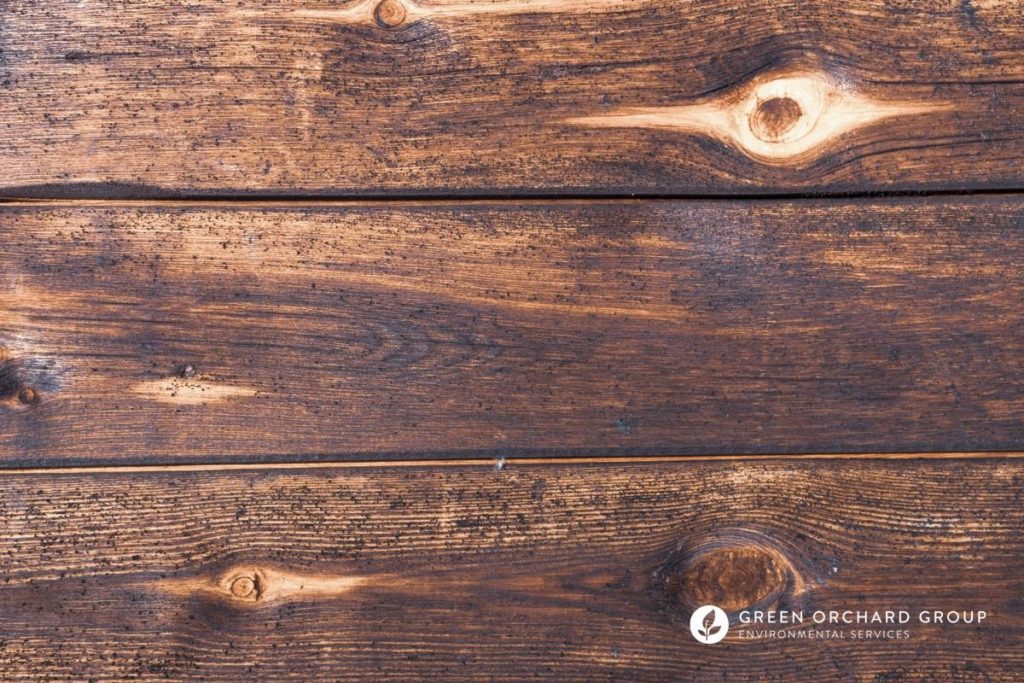
Not only is mold on the floor unpleasant to look at, it can also be hazardous for your health.
Certain types of mold, such as black mold, release mycotoxins and other harmful chemicals into the air as they grow. Mold spores can also trigger or exacerbate asthma and allergy symptoms while you’re at home.
Here’s what you can do to find out if you have mold on your floor and how to remove it.
What Causes Mold to Grow On Floors?
Mold growth always starts with one thing: moisture.
If your floors are exposed to any amount of excess moisture — it could be in the form of a water leak, condensation, steam, or humidity — there’s a chance that mold can grow. Cleaning up spills and leaks quickly helps prevent mold growth, but if you didn’t dry your floors thoroughly enough, it could lead to mold.
Once mold starts to grow on or underneath your flooring, it can cause staining, buckling, or even cause parts of your floor to rot.
Some types of flooring are particularly susceptible to mold, such as hardwood floors, which can trap or absorb moisture. Water can leak in between cracks and collect underneath without you noticing. On the other hand, tile and vinyl flooring is waterproof and therefore more resistant to mold.
Signs of Mold under Hardwood Floors
Sometimes mold on flooring is readily visible to the naked eye. You might notice patches of discoloration (usually black or green, although mold can grow in a variety of different colors) with a slimy or fuzzy texture.
Other times, mold isn’t so easily seen if it’s growing under the floorboards, on the floor joists, or on the subfloor. Some warning signs to look out for, especially if you recently experienced a water leak or flooding, include:
- Musty odors
- Creaky floorboards
- Buckling or warping
- Discoloration
- Water stains
- Water damage
- Health symptoms associated with mold exposure
Any of these signs by themselves can have other causes, but noticing several of them at a time might help help strengthen your suspicions of mold growth.
The only way to know for sure is to carefully pull up the floorboards or tiles where you suspect mold to be growing underneath. You can also use a mold test kit or have your home inspected by a professional, depending on your budget and the severity of mold.

How to Remove Mold from Flooring
If you’re sure that you have mold growing on your floor, it’s important to remove it properly. Mold can be a serious indoor environmental hazard that, over time, can cause a variety of health problems.
For a minor mold issues, you can try to clean and remove it yourself. Just make sure that you’re wearing gloves, goggles, and a N-95 mask to protect yourself from potential toxins.
- Before you start, make sure that your floor is completely dry. Remove any excess water or moisture using a towels or dehumidifiers. Use a vacuum with a HEPA filter to remove loose mold spores and debris.
- Clear the surrounding area of clutter and furniture. If you have rugs or furniture that were in contact with the mold, you’ll need to remove them for cleaning and drying. In some cases they might need to be discarded and replaced.
- Open windows for ventilation. If you have a fan, use it to blow the moldy air towards the window.
- If needed, carefully remove carpeting and pry off wall trimming and flooring to expose the moldy area. You might need a scraper to peel off vinyl or linoleum.
- Scrub the affected area with a mixture of hot water and soap.
- Use an appropriate mold and mildew cleaner to disinfect the area. You can also use a diluted bleach solution (mix 1 cup of bleach in 1 gallon of water). Spray this cleaning solution directly onto the moldy floor and allow it to sit for 10 to 15 minutes.
- Rinse with clean water and then dry it thoroughly with towels or dehumidifiers.
These steps should help you remove small areas of mold, assuming that it hasn’t spread extensively beyond what you expected. After you’re done cleaning, you may need to install new flooring depending on how far the mold penetrated.
However, if the mold persists, or has penetrated deeply under the surface, consider getting professional help to remove it for good.
Professional Mold Removal in New York City
For professional mold remediation in New York City, contact Green Orchard Group today. We are a leading environmental company in NYC with over 25 years of experience providing licensed mold inspection and remediation services.
